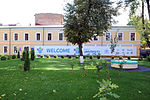Rybalskyi Peninsula
Neighborhoods in KyivPeninsulas of UkraineRybalskyi Island

Rybalskyi Island (Ukrainian: Рибальський півострів, Рибальський півострів.ogg translit. Rybalskyi ostriv; literally: Fisherman's island) is a misnomer for an actual peninsula on the Dnieper River, located in the right-bank Podil neighborhood and Kyiv Harbor of the city of Kyiv. Although named as an island it is in fact a peninsula and a former spit serving as a left-bank of a former Pochaina River that with time transformed into several oxbow lakes located in Obolon (see Opechen lakes). The peninsula is now a predominantly industrial area.
Excerpt from the Wikipedia article Rybalskyi Peninsula (License: CC BY-SA 3.0, Authors, Images).Rybalskyi Peninsula
Elektrykiv Street, Kyiv Podil
Geographical coordinates (GPS) Address Nearby Places Show on map
Geographical coordinates (GPS)
| Latitude | Longitude |
|---|---|
| N 50.48 ° | E 30.53 ° |
Address
Elektrykiv Street
04176 Kyiv, Podil
Ukraine
Open on Google Maps










